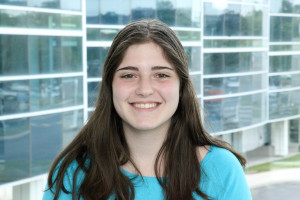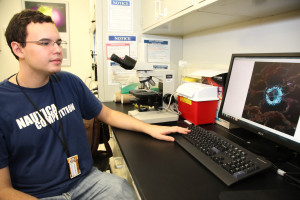Undergrads are co-first authors on publication
When the Journal of Biophotonics published Biodistribution of inhaled metal oxide nanoparticles mimicking occupational exposure: a preliminary investigation using enhanced darkfield microscopy, the article had something a bit unusual amid its bylines – two authors who were not graduate or PhD students, but undergrads.
Co-first authors Marissa Guttenberg and Leonardo Bezerra are undergraduate students at SUNY Polytechnic Institute’s Colleges of Nanoscale Science and Engineering.
The students, along with students at the University of Rochester, worked with Dr. Sara Brenner, Associate Professor of Nanobioscience and Assistant Vice President for NanoHealth Initiatives at CNSE, to investigate the application of enhanced dark field microscopy (EDFM) to identify nanomaterials in tissue samples obtained from animals following inhalation exposure to metal oxide nanoparticles used in industrial settings, specifically the semiconductor industry.
Brenner says the goals were to identify and characterize the retention and location of nanoparticles in the lungs (alveolar space, blood vessels, macrophages), assess the potential for biodistribution to other organs (lymph nodes, liver, kidney, spleen), and identify specific locations of nanoparticles within anatomical regions of interest within each organ.
The study found that EDFM can be used to achieve these goals, and it also provides a rapid, cost-effective alternative to conventional methods for direct visualization of nanomaterials in biological samples; EDFM can be used in tandem with other methods by serial sectioning of the sample to provide complementary information; and metal oxide nanoparticles used in industry, when inhaled, have the potential to translocate from deposits in the lung to different organs via the circulatory and lymphatic systems.
“This publication is a testament to the incredible work ethic and talent of our CNSE undergraduate students,” Dr. Brenner said. “Marissa actually joined our team as a high school student, was then admitted to CNSE, and has continued working with my group for two years. This summer, she was offered a 10 week industry-sponsored internship conducting microscopy research at CytoViva’s headquarters in Alabama (advancing the applications described in this paper). She is a rising Junior and re-joined our team at CNSE in the Fall.”
Marissa Guttenberg recently attended and presented a poster at the 8th International Nanotoxicology Congress Meeting in Boston in June 2016 – a meeting attended by 400 people from 30 different countries. She was one of only 28 students selected for $1,000 travel award.
“Leo Bezarra just graduated in May after spending several years doing research with my group, and while on our team, he developed many methods and procedures we use today,” Dr. Brenner said. “He was undoubtedly one of the most skilled microscopists we’ve had on our team (of any age, over the past seven years).”
Bezarra began graduate school as a PhD student at Virginia Tech in the Fall 2016 semester.
Recent Comments
Archives
- September 2018
- August 2018
- May 2018
- April 2018
- March 2018
- February 2018
- January 2018
- December 2017
- November 2017
- October 2017
- September 2017
- May 2017
- April 2017
- March 2017
- February 2017
- January 2017
- December 2016
- November 2016
- October 2016
- September 2016
- August 2016
- May 2016
- April 2016
- March 2016
- February 2016
- January 2016
- December 2015
- November 2015
- October 2015
- September 2015
- August 2015
- May 2015
- April 2015
- March 2015
- February 2015
- January 2015
- December 2014
- November 2014
- October 2014
- September 2014
- August 2014
- May 2014
- April 2014
- March 2014
- February 2014
- January 2014
- December 2013
- November 2013
- October 2013
- September 2013
- August 2013
- June 2013
- May 2013
- April 2013
- March 2013
- February 2013
- January 2013
- December 2012
- November 2012


